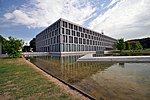Erfurt school massacre
2000s in Thuringia2002 mass shootings in Europe2002 murders in Germany2002 suicidesAll pages needing cleanup ... and 19 more
April 2002 crimesApril 2002 events in GermanyColumbine High School massacre copycat crimesCrime in ThuringiaDeaths by firearm in GermanyHigh school killings in EuropeHigh school shootingsHistory of ErfurtMass murder in 2002Mass shootings in GermanyMassacres in GermanyMurder–suicides in GermanySchool killings in GermanySchool massacres in EuropeSchool shootings committed by pupilsSchool shootings in GermanySpree shootings in GermanySuicides by firearm in GermanyWikipedia pages needing cleanup from March 2023

The Erfurt massacre was a school shooting that occurred on 26 April 2002 at the Gutenberg-Gymnasium, a secondary school in Erfurt, Germany. 19-year-old expelled student Robert Steinhäuser shot and killed 16 people, including 13 staff members, 2 students, and 1 police officer before committing suicide. One person was also wounded by a bullet fragment. According to students, he ignored them and aimed only for the teachers and administrators, although 2 students were unintentionally killed by shots fired through a locked door.
Excerpt from the Wikipedia article Erfurt school massacre (License: CC BY-SA 3.0, Authors, Images).Erfurt school massacre
Gutenbergplatz, Erfurt Andreasvorstadt
Geographical coordinates (GPS) Address Nearby Places Show on map
Geographical coordinates (GPS)
| Latitude | Longitude |
|---|---|
| N 50.981388888889 ° | E 11.014722222222 ° |
Address
Gutenbergplatz
Gutenbergplatz
99092 Erfurt, Andreasvorstadt
Thuringia, Germany
Open on Google Maps










